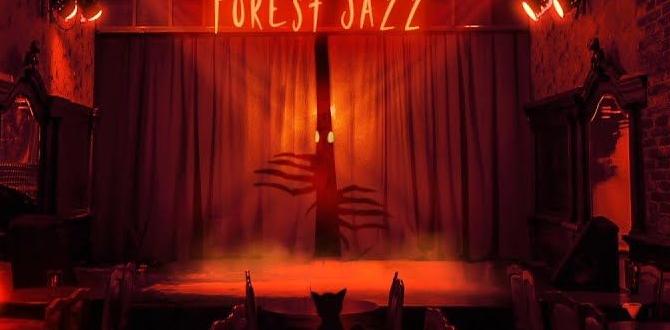Quick Summary: Discovering safer areas in the Black Forest is straightforward. Focus on well-established tourist towns, natural parks with clear trails, and accommodations with good reviews. Avoiding isolated, poorly-lit areas, especially at night, is key. Always exercise common sense, and you’ll have a wonderful, secure experience.
Planning a trip to the breathtaking Black Forest? It’s a dream destination for many, offering lush forests, charming villages, and stunning natural beauty. However, like any popular region, knowing where to focus your exploration for safety and ease is important. You might be wondering which spots are best for a relaxed visit, especially if you’re traveling with family or seeking a tranquil escape. Don’t worry, this guide is here to help!
We’ll walk you through identifying the most welcoming and secure locations, ensuring your adventure is filled with unforgettable memories, not anxieties. Get ready to plan a journey that’s both beautiful and blessedly worry-free. We’ll cover everything from popular tourist hubs to serene natural spots, making your Black Forest experience as smooth as a forest path.
Understanding Safety in the Black Forest
The Black Forest (Schwarzwald in German) is renowned for its unparalleled natural beauty and is generally a very safe region. Tourism is a significant part of its economy, meaning many areas are well-maintained and geared towards visitor comfort and security. However, like anywhere in the world, being aware of your surroundings and taking sensible precautions is always a good idea.
For most visitors, the Black Forest presents no significant safety concerns. The primary “risks” are often related to natural elements, such as navigating uneven forest trails or enjoying outdoor activities responsibly. Petty crime is rare, especially in tourist hotspots and smaller villages.
Natural Safety Considerations
The vastness of the Black Forest means encountering nature is part of the experience. Understanding these aspects helps ensure a safe trip:
- Marked Trails: Always stick to well-marked hiking trails. The forest can be dense, and straying from marked paths can lead to disorientation. Many trails are managed by local hiking associations, which maintain their safety and clarity. The Schwarzwaldverein (Black Forest Association) is a key organization maintaining and marking thousands of kilometers of trails.
- Weather Changes: Mountain weather can change rapidly. Be prepared for sudden shifts in temperature, rain, or fog, especially at higher elevations. Check the weather forecast before setting out on hikes.
- Wildlife: While large predators are virtually non-existent, you might encounter deer, wild boar, or foxes. They are generally shy and pose no threat if given space.
- Sun and Insect Protection: Apply sunscreen, wear a hat, and use insect repellent, particularly during warmer months.
General Travel Safety
Beyond the natural environment, standard travel precautions apply:
- Valuables: As with any destination, keep an eye on your belongings, especially in crowded tourist areas or on public transport.
- Emergency Numbers: Know the European emergency number, 112, which connects you to police, ambulance, and fire services.
Essential Safer Areas in the Black Forest
When planning your visit, focusing on areas known for their infrastructure, accessibility, and popularity among tourists will naturally lead you to the most secure and convenient spots. These locations are generally more frequented, have better services, and are under the watchful eye of local authorities.
1. Popular Tourist Towns and Villages
These hubs are the heart of Black Forest tourism and are exceptionally safe.
Freiburg im Breisgau
While technically bordering the Black Forest, Freiburg is often the gateway for many visitors. It’s a vibrant university city with a charming old town (Altstadt) featuring its famous “Bächle” (small water channels) and the impressive Freiburg Minster. It’s well-connected by public transport and offers a wide range of accommodations and dining. The city is known for its progressive and welcoming atmosphere.
Titisee-Neustadt
Famous for its picturesque lake, Titisee is a prime destination for relaxation and outdoor activities. The town itself is geared towards tourism, with numerous hotels, restaurants, and shops. Walking around the lake and the town is very safe, with plenty of people around, especially during peak season.
Triberg
Known for Germany’s highest waterfalls and cuckoo clocks, Triberg is a classic Black Forest destination. It’s a walkable town with good tourist facilities. The area around the waterfalls is well-maintained and patrolled during opening hours. Staying in Triberg or nearby allows easy access to many attractions.
Gengenbach
This remarkably well-preserved medieval town is incredibly charming and popular, especially during its carnival season. Its picturesque alleys and half-timbered houses make it feel like stepping back in time. Gengenbach is small, safe, and easy to navigate.
Schönau im Schwarzwald
Located in the southern Black Forest near the Feldberg, Schönau is a great base for exploring the alpine regions. It’s a typical, friendly German town with good amenities and a strong connection to nature.
2. Designated Natural Parks and Recreation Areas
These areas are managed for public enjoyment and safety.
Schwarzwald National Park (Nationalpark Schwarzwald)
Germany’s only national park in the low mountain range is designed for conservation and visitor experience. It features extensive, well-marked hiking trails, ranger-led tours, and clearly defined viewpoints. The park authorities prioritize visitor safety with clear signage and guidance.
The park is divided into different zones, but the core visitor areas are very accessible. For example, trails around the Mummelsee, one of the glacial lakes within the park, are popular and safe. You can find more information on trail safety and recommendations on the Nationalpark Schwarzwald official website.
Feldberg Region
As the highest peak in the Black Forest, Feldberg is a hub for hiking in summer and skiing in winter. The summit area and surrounding trails are well-developed. During ski season, patrols ensure safety on the slopes. In summer, the marked paths are clear, and cable cars offer easy access to higher points, making it accessible for a wide range of fitness levels.
Lake Titisee and Schluchsee Areas
These large glacial lakes are central to many Black Forest holidays. The areas surrounding the lakes are well-developed with walking paths, cycling routes, and water sports facilities. They are always populated with other visitors, adding an extra layer of security.
3. Areas with Strong Tourist Infrastructure
Regions or towns that have invested heavily in tourism generally offer a higher level of safety and service.
The “Schwarzwald-Hochstraße” (B500) Scenic Route
This is one of Germany’s oldest and most famous scenic routes, running along the ridge of the Northern Black Forest. While it’s a road, the areas along it, such as the viewpoints and small inns, are very popular and safe. It’s a great way to experience the landscape without strenuous hiking, with stops at places like Mummelsee or Ruhestein.
| Type of Area | Why it’s Safer | Key Attractions | Best for |
|---|---|---|---|
| Popular Tourist Towns (e.g., Titisee, Triberg, Gengenbach) | High visitor numbers, good infrastructure, visible local presence. | Lakes, waterfalls, historic architecture, cuckoo clocks. | Families, first-time visitors, those seeking convenient amenities. |
| National Park Areas (e.g., Schwarzwald National Park) | Managed by park authorities, clear signage, marked trails, ranger presence. | Wild forests, hiking, wildlife spotting, nature experience. | Nature lovers, hikers, those seeking a serene, guided experience. |
| Mountain Resorts (e.g., Feldberg) | Well-maintained trails, winter sports safety measures, access via cable car. | Panoramic views, hiking, skiing, mountain biking. | Active travelers, families, winter sports enthusiasts. |
| Scenic Routes (e.g., Schwarzwald-Hochstraße) | Frequent visitors, accessible viewpoints, accessible by car. | Scenic drives, viewpoints, short walks. | Travelers with vehicles, those preferring less strenuous activities. |
Areas That Might Require More Caution (and Why)
It’s less about “avoiding” specific places entirely and more about understanding where to exercise extra vigilance. These are typically areas that are less frequented or have characteristics that require more preparation.
1. Very Remote or Isolated Forest Sections
While beautiful, venturing deep into unmarked or rarely used forest areas without proper preparation can pose challenges.
- Getting Lost: The sheer density of the forest means it’s easy to lose your bearings if you stray from marked paths or if GPS signals are weak.
- Limited Services: In truly remote areas, you won’t find readily available assistance if you encounter a problem.
2. Unlit or Less-Trafficked Rural Roads at Night
As with rural areas anywhere, driving on unlit roads after dark requires careful attention.
- Wildlife on Roads: Animals crossing roads are a common hazard in rural and forest areas, especially at night.
- Poor Visibility: Winding roads and lack of street lighting can make driving challenging.
3. Areas Undergoing Construction or Unmaintained Trails
Sometimes, popular spots might have sections closed or under repair. It’s always wise to heed warning signs.
- Potential Hazards: Unmaintained trails can have unexpected obstacles or erosion issues.
- Detours: Following unofficial detours can lead you to less safe or challenging terrain.
For official information on current trail conditions or park alerts, consult local tourist information offices or the park management websites. For instance, the Baden-Württemberg government provides updates relevant to outdoor access, which can be useful.
Tips for a Safe and Enjoyable Black Forest Experience
Following these practical tips will help ensure your trip is smooth and stress-free, allowing you to fully immerse yourself in the magic of the Black Forest.
- Plan Your Itinerary: Research your chosen destinations. Look for areas with good public transport links (like the KONUS card, which often provides free local transport for tourists staying in participating towns) and a variety of accommodation and dining options.
- Stay Connected (When Possible): While it’s a great place to disconnect, having a charged phone is always wise. Consider a portable power bank, especially for longer hikes.
- Inform Someone of Your Plans: If you’re going on a serious hike, especially alone, let your accommodation provider or a friend know your route and expected return time.
- Pack Appropriately: Comfortable, sturdy footwear is essential for exploring. Layers of clothing are recommended due to varying mountain weather. Don’t forget a basic first-aid kit, especially for hikes.
- Respect Nature: Stay on marked paths, do not litter, and refrain from feeding wildlife. This helps preserve the environment and ensures your safety.
- Utilize Tourist Information Centers: These centers are invaluable resources for local maps, safety advice, and up-to-date information on trail conditions or events.
- Child Safety and Diapering Needs: If traveling with young children or needing personal care items, plan accordingly. While supermarkets and pharmacies in larger towns stock common items, having a supply of child diapers or adult diapers for longer journeys or more remote excursions can provide peace of mind. Many online retailers specialize in discreet delivery of these essentials, ensuring you’re prepared no matter where your Black Forest adventure takes you. For example, services like LiveWell (offering various incontinence products) can be researched for at-home delivery before your trip.
FAQ Section
Q1: Is the Black Forest generally safe for solo female travelers?
Yes, the Black Forest is widely considered very safe for solo female travelers. The region has a low crime rate, and tourist areas are accustomed to visitors of all kinds. Standard precautions, like being aware of your surroundings and avoiding poorly lit areas at night, are always recommended.
Q2: Are there any specific areas I should completely avoid in the Black Forest?
There are no specific “no-go” zones that are commonly known or advised against. The focus should be on understanding where to be more cautious, such as very remote, unmarked forest paths, rather than avoiding entire regions.
Q3: What if I get lost while hiking?
If you get lost, stay calm. Try to retrace your steps. If that’s not possible, stay put, especially if it’s getting dark or the weather is bad. Use your phone to call emergency services (112) if you have signal. Look for signs of human activity or well-marked trails. Most hiking areas are well-covered by trail markers.
Q4: Is it safe to drink tap water in the Black Forest?
Yes, tap water in Germany, including the Black Forest region, is safe to drink. It is of high quality and regularly tested.
Q5: What kind of safety equipment should I bring for hiking?
For day hikes, a small backpack with water, snacks, a basic first-aid kit, a map, a compass or GPS device, and appropriate clothing for changing weather conditions is advisable. For longer or more challenging hikes, consider a headlamp, emergency blanket, and a whistle.
Q6: Are the Black Forest’s tourist attractions well-monitored for safety?
Generally, yes. Popular tourist attractions, especially those with entrance fees (like waterfalls or scenic viewpoints), often have staff present during operating hours. For natural sites within parks, safety is managed through clear signage and trail maintenance.
Q7: How easy is it to find pharmacies or medical help in the Black Forest?
Pharmacies (Apotheken) are common in towns and cities. Medical centers and doctors are also readily available in most larger communities. For emergencies, dial 112. For non-emergencies requiring medical attention, your hotel or local tourist information can direct you to the nearest facility.
Conclusion: Enjoying Your Secure Black Forest Adventure
The Black Forest is a treasure trove of natural beauty and cultural charm, and nearly all of it is accessible for a safe and enjoyable visit. By choosing to stay in or explore well-established tourist towns, designated natural parks, and areas with robust infrastructure, you’re setting yourself up for a worry-free experience. Remember that common sense, preparedness, and respecting the natural environment are your best guides.
Whether you’re an avid hiker charting remote paths (with proper navigation, of course) or a family seeking gentle strolls around crystal-clear lakes, the Black Forest offers a secure and welcoming environment. By focusing on the tips and areas discussed, you can confidently plan your trip, knowing that a breathtaking and safe adventure awaits. So pack your bags, embrace the scenery, and create lasting memories in this enchanting German gem.





